
This year I am making much more effort to get sufficient protein into my diet. After being told by various doctors that my intake was too low, I have been focusing on some recipes to aid me in reaching a protein goal. On the menu today are these gluten free protein pancakes without protein powder.
I know that not everybody likes to use protein powder which was the inspiration for these pancakes. They are made with simple ingredients and only take 10 minutes to make, start to finish. An easy high protein breakfast or snack for everyone.
A note, before we dive in. Are these the most delicious, light and fluffy pancakes you have ever had in your life? No. They are protein pancakes 🙂 I have developed this recipe to work for those on high protein, low sugar diets. If you’d like a delicious fluffy pancake, try my gluten free ricotta pancakes. They still have a good amount of protein, but are not designed to be a ‘healthy’ recipe per se.
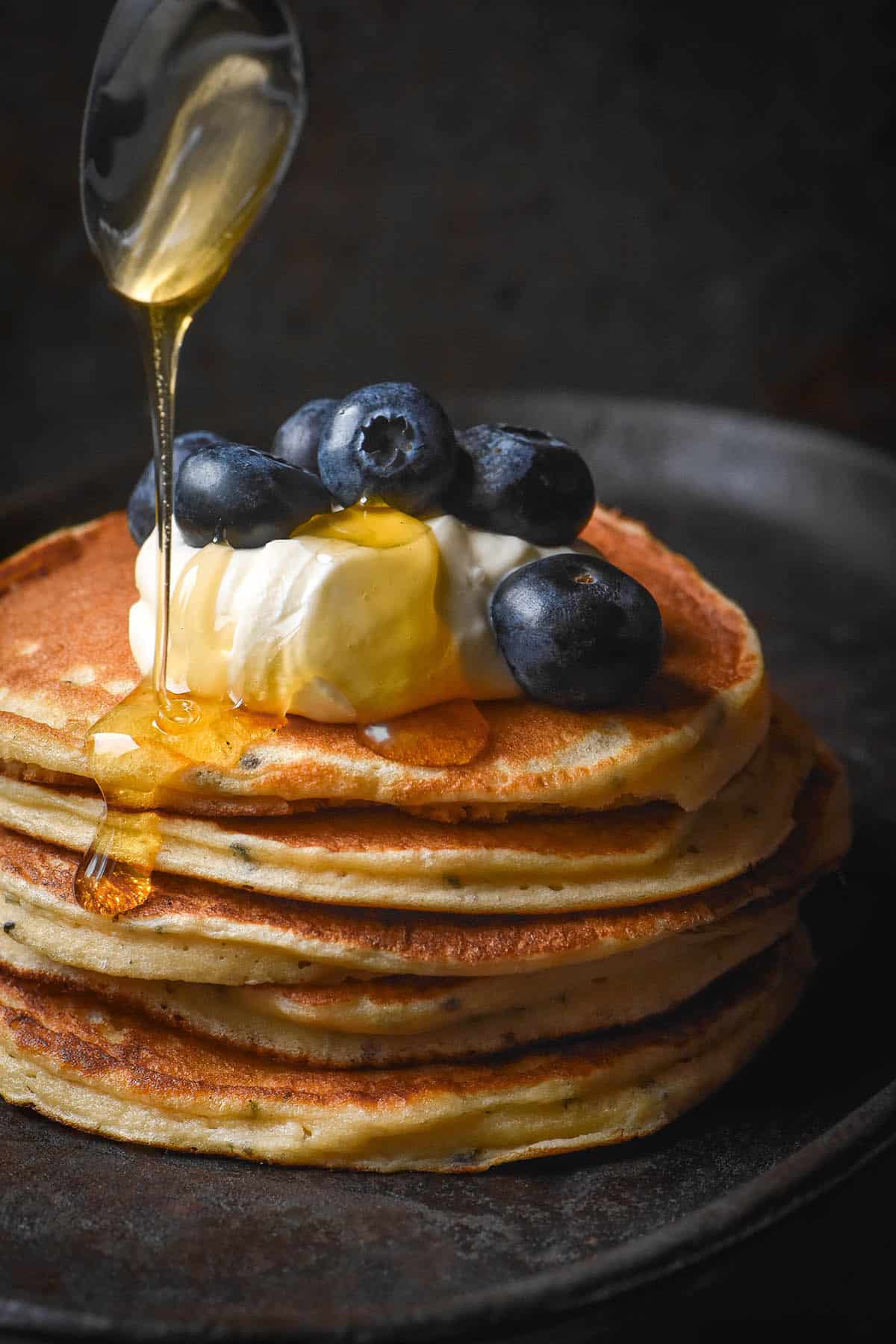
Gluten free protein pancakes without protein powder
These pancakes are oat free, gluten free, nut free and have an easy grain free option. With the right yoghurt, they are low FODMAP too. They use high protein yoghurt (more on that below), buckwheat or cassava flour, an egg and a tablespoon of hemp seeds.
In Australia, oats are considered wheat free but not gluten free. A lot of recipes for protein pancakes use oats, too, which is why I decided to develop a recipe without oats.
These pancakes are naturally high in different sources of complete protein. The buckwheat version benefits from 60ml (1/4 cup) of milk, which can bring the protein total for that recipe to nearly 37g. Any which way the recipe is made (with the right yoghurt) it contains at least 30g of protein per serve.
How much protein do these protein pancakes contain?
Protein content does vary on the brand you buy, so take this section as a guide only.
As we will discuss below, this recipe uses high protein yoghurt. I use Chobani Fit (I like blueberry or vanilla flavour) which contains 15g of protein for a 160g tub at the time of writing. This recipe uses 160g of yoghurt to make it very straightforward.
Next, the recipe uses an extra large egg. An extra large egg contains approximately 7g of protein.
This recipe uses 25g (1 Australian tablespoon) of hemp seeds in the batter. I find that you only just notice them slightly as you eat the pancakes, but they contain a whopping 8g of complete protein. I used Red Tractor Foods brand, so your protein content might vary a little bit if you choose a different brand.
Next, you have the option to use light buckwheat flour or cassava flour. Light buckwheat flour contains around 6g of protein per 50g of flour (which is the amount this recipe uses). Cassava flour doesn’t contain much protein at all, but I wanted to give both a grain free option and an option for those who don’t like buckwheat flour. The buckwheat version does taste a little ‘healthy’.
Finally, we have the milk. If you use the buckwheat version, you might benefit from 20-60ml (1-3 Australian tablespoons) of milk. Regular cow’s milk contains around 2g protein for every 3 tablespoons.
TLDR
- Pancakes made with Chobani Fit yoghurt, extra large egg, 1 tablespoon hemp seeds, buckwheat flour and milk = approximately 36-37g protein
- Pancakes made with Chobani Fit, extra large egg, 1 tablespoon hemp seeds and cassava flour = approximately 30g protein
- Pancakes made with non-protein Greek yoghurt, extra large egg, 1 tablespoon hemp seeds, buckwheat flour and milk = approximately 26-27g protein
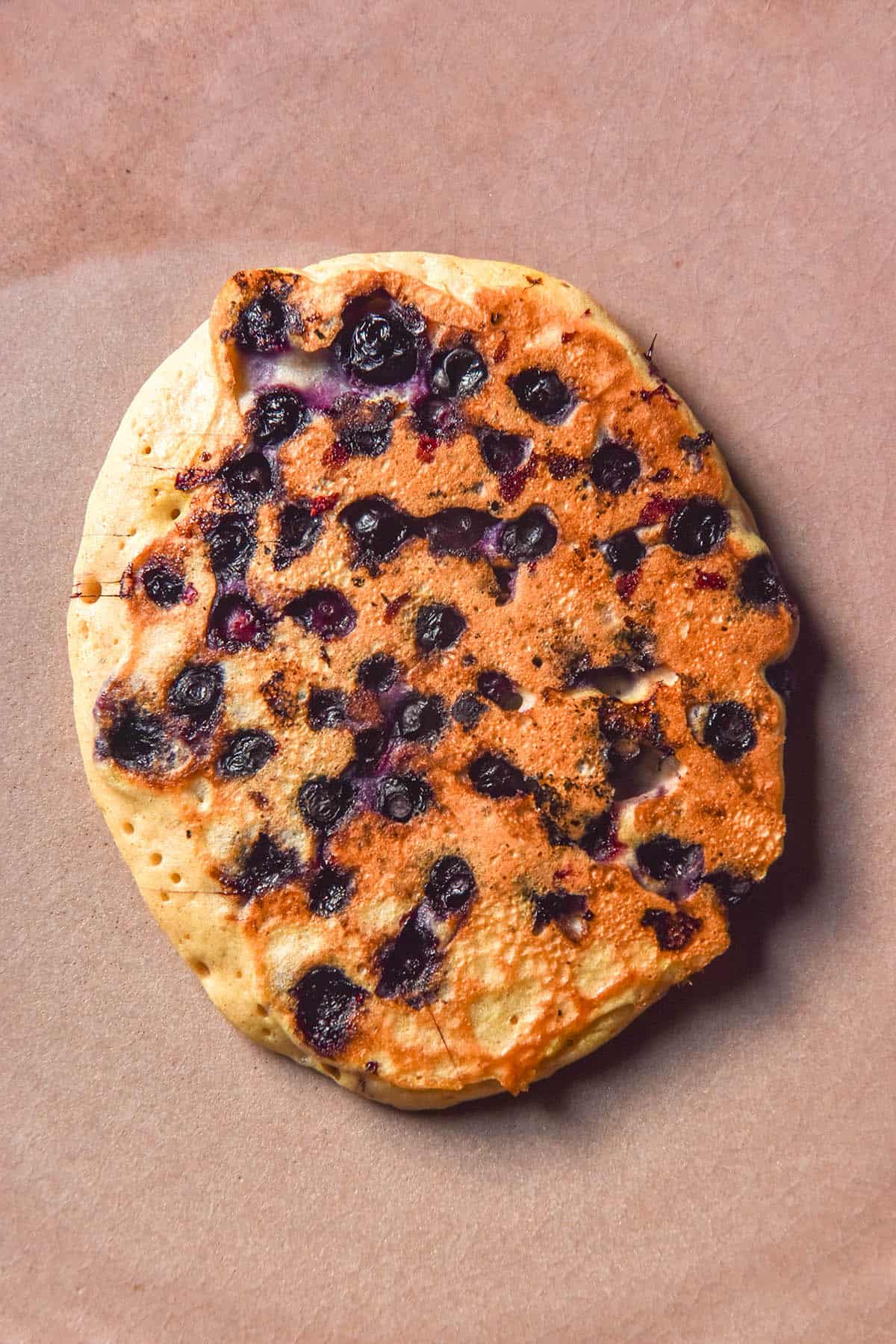
Notes on the yoghurt
I’m not sure if this is a global phenomenon, but protein yoghurt is all the rage here in Australia. It is very convenient and a complete protein, which makes it a great ingredient for upping your protein content.
My personal favourite (for a number of reasons) is the Chobani Fit range. Although they don’t seem to advertise it, these protein yoghurts have added lactase. As such, it’s a lactose free option that works for us lactose averse and low FODMAP girlies.
I normally love Jalna lactose free Greek yoghurt, but an examination of the tub reveals that it isn’t high in protein. Hence, protein yoghurt!
The recipe uses 160g of yoghurt which is based on a Chobani Fit tub or a serve of their larger tubs. I’m not sponsored by them (I wish) but this is my protein yoghurt of choice here in Australia.
Of course, the final protein tally for your protein pancakes will depend on which brand you use. I have totalled the protein based on using a high protein yoghurt.
If you need a dairy free option, I have tested two high protein plant based yoghurts here (Cocobella and Soylife). They both worked well.
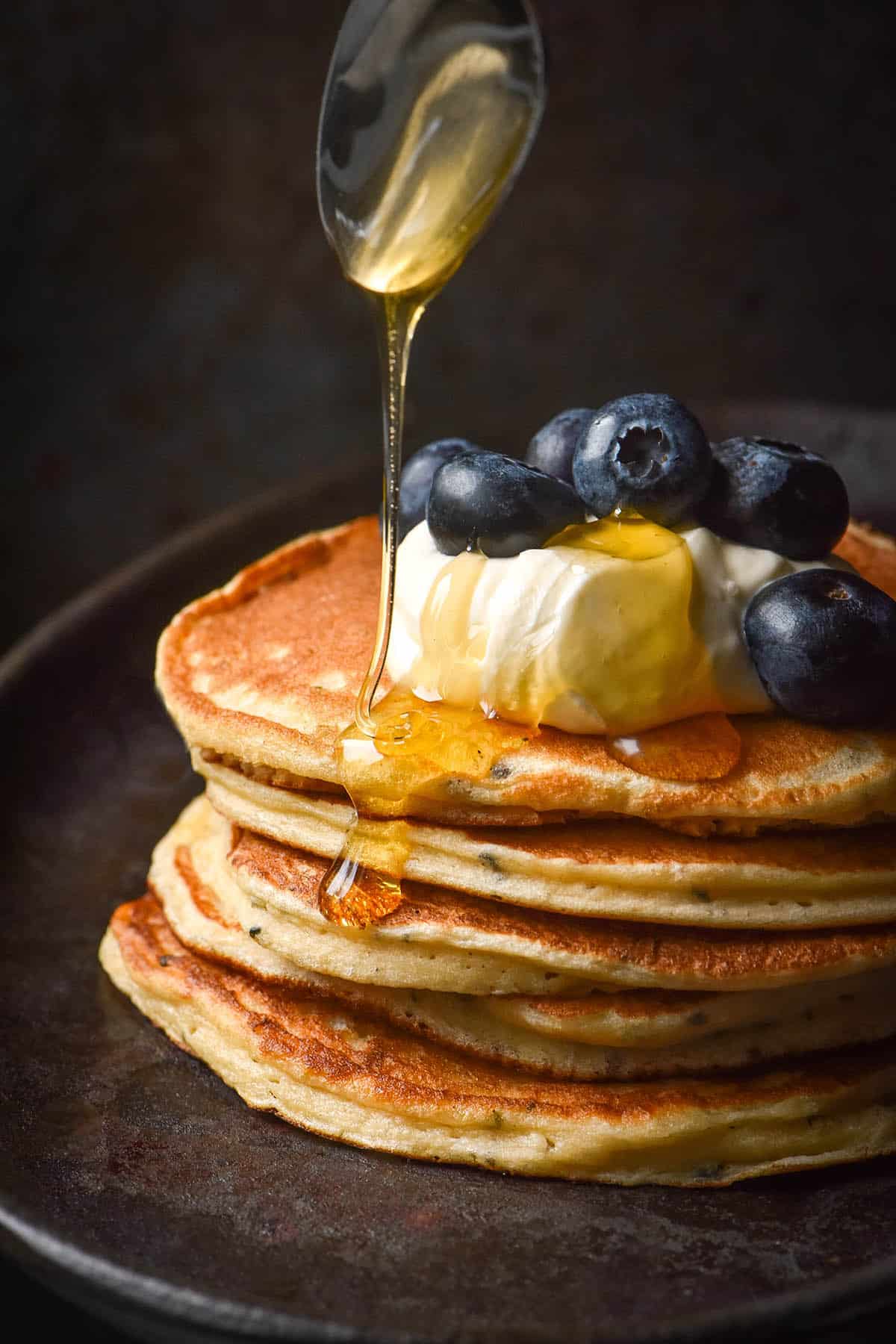
What sweeteners can I use in these protein pancakes without protein powder?
Even with the flavoured yoghurts, these protein pancakes can be a little bland. The sweeteners in the yoghurt brands I tested aren’t generally enough to fully sweeten the pancakes. Because I am assuming a lot of people using this recipe will be conscious of added sugar, I have kept it to an absolute minimum.
So, what have I tested? Firstly, I will note that my preference is to drizzle these pancakes with maple syrup or sugar and lemon juice. I prefer to have the sweetness on the outside as I find I don’t notice the lack of sweetness within.
However, I have tested a number of different options for sweetener.
- 2-3 teaspoons of maple syrup in the batter (only add milk as needed)
- 2-3 teaspoons light brown sugar in the batter (only add milk as needed)
- 25-50g mashed ripe banana
- Stevia drops, to your tastes
- Maple syrup or white sugar and lemon, to finish
I haven’t tested any other sweeteners. You’re welcome to try, but I can’t guarantee any results. With that said, these have been pretty flexible with all the different yoghurt and flour combinations I have tried, so fingers crossed.

Recipe notes and tips
- These are ‘healthier’ pancakes. Don’t expect them to taste like the fluffiest most delicious pancake you have ever had!
- Cassava flour gets quite chewy and gooey when too much liquid is added. I recommend trying to use as little milk as possible when you make the cassava flour version.
- Personally, I prefer to keep the sweeteners to a minimum and then use maple syrup to finish my pancakes. The choice is yours – you can add some brown sugar or maple syrup to the pancake batter.
- I haven’t tested and have no experience with artificial sweeteners like allulose or monk fruit. I can’t offer any advice as to whether they will work or how to use them.
- I do recommend using flavoured protein yoghurt to make these pancakes a little more exciting. I think plain Greek yoghurt would make for quite a tangy pancake, particularly if you don’t intend to add any sweetener.
- I like to dot my pancakes with fresh or frozen blueberries to add a bit of excitement and extra flavour. I just eyeball how many I fancy on each pancake and they come out fine every time.
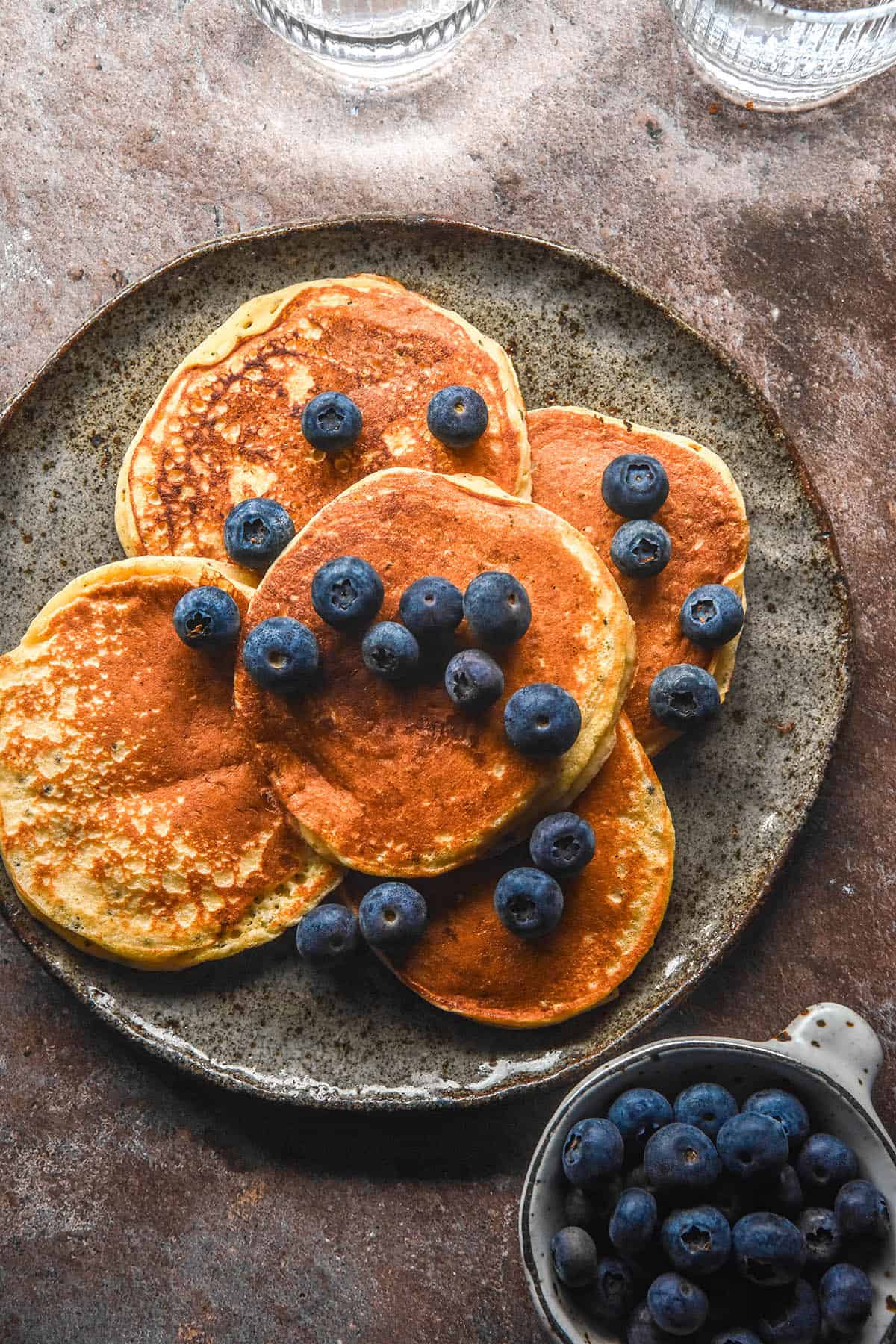
More gluten free high protein recipes
- Gluten free high protein bread
- Gluten free vegan high protein bread
- Gluten free high protein bagels
- Gluten free protein mug cake (whey based, dairy free or vegan)
- Gluten free protein pancakes that use protein powder (dairy free or vegan)
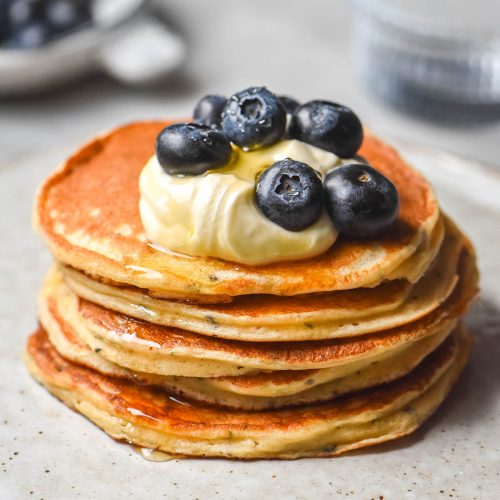
Protein pancakes without protein powder
Ingredients
For the pancakes:
- 160 g high protein yoghurt (Chobani Fit is my preference, but I have also tested YoPro and Cocobella and Kingland protein yoghurts for dairy free options) see notes
- 1 extra large egg 45-55g, weighed out of shell
- 50 g light buckwheat flour or cassava flour
- 3g (1/2 teaspoon) gluten free baking powder
- 2-3 tsp maple syrup or sugar, for the pancake batter (optional, can omit)
- 25 g hemp seeds (optional, see notes)
- 20-60ml (1-3 tablespoons)* milk of choice, only as necessary
- oil, to cook the pancakes
Optional ingredient:
- fresh or frozen blueberries, to stud the pancakes (use as few or as many as you like)
To finish (optional):
- drizzle of maple syrup
- berries, banana coins or fruit of choice
Instructions
- Whisk together the yoghurt, egg, flour of choice and baking powder in a medium mixing bowl. If you are adding sweetener to the pancakes, add it here. Add the hemp seeds and whisk to combine.
- If your batter is spoonable and smooth, you don't need to add any milk. If the batter is looking quite thick, add milk 10-20ml at a time until you reach your desired consistency. This will depend on the yoghurt brand and how thick it is. You can always add some after the first pancake if it is feeling thick.
- Preheat a nonstick pan over a medium heat. Once thoroughly heated, add a splash of oil (or not, these also work without oil) and allow it to spread.
- Turn the heat to low, then spoon about 2 Australian tablespoons (2 1/2 tablespoons elsewhere) of batter per pancake. If you want to make blueberry or choc chip pancakes, stud the pancakes with berries/choc chips here.
- Allow the pancake to cook for about 30 seconds or until bubbles appear on the surface. Gently flip and repeat. Adjust the heat as necessary so your pancakes are golden brown and not overdone but still cooked through.
- Repeat with the remaining batter for about 3-4 pancakes. Serve with your toppings of choice. These pancakes can also be made ahead and placed in an airtight container in the fridge.
Notes
- For low FODMAP high protein pancakes, use Chobani Fit (as it is lactose free). 2 tablespoons of maple syrup is a low FODMAP serve. Use a low FODMAP fruit (like blueberries) to top the pancakes. Both cassava flour and buckwheat flour are low FODMAP in 100g serves per person and neither have an upper limit in the app as of June 2025. Hemp seeds are low FODMAP in 20g serves but Monash doesn’t list an upper limit. They used to have an upper threshold which you can find here. Use 20g if you want to be cautious.
- I have successfully tested soy protein yoghurt and coconut protein yoghurt in these pancakes.
- Pancakes made with Chobani Fit yoghurt, extra large egg, 1 tablespoon hemp seeds, buckwheat flour and milk = approximately 36-37g protein
- Pancakes made with Chobani Fit, extra large egg, 1 tablespoon hemp seeds and cassava flour = approximately 30g protein
- Pancakes made with non protein Greek yoghurt, extra large egg, 1 tablespoon hemp seeds, buckwheat flour and milk = approximately 26-27g protein.
- Pancakes made with Cocobella protein yoghurt, extra large egg, 1 tablespoon hemp seeds, buckwheat flour and milk = approximately 29g protein.

No Comments